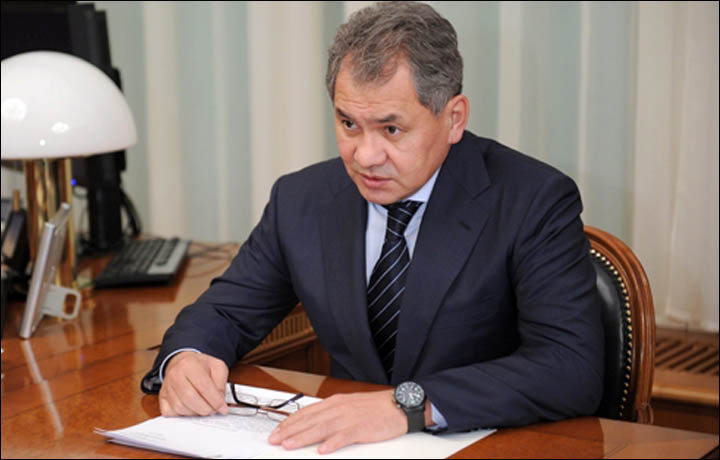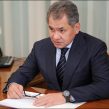
Ded Moroz, Sergei Shoigu and the ‘Magic’ of the Russian Media (Part One)
Publication: Eurasia Daily Monitor Volume: 11 Issue: 12
By:

In the aftermath of the Russian holiday season and its familiar linkage to Ded Moroz (Father Frost), naive beliefs appear seasonably appropriate. Since the appointment of Russia’s defense minister, Army-General Sergei Shoigu, in November 2012, opinion polls continue to confirm him as one of the most popular politicians in the country (https://fmso.leavenworth.army.mil/documents/Finch-Shoygu.pdf).
Shoigu is the most popular minister in the Russian government, as recently shown in polls conducted by the All-Russian Public Opinion Research Center (VTsIOM). According to that poll, on a five-point scale, Shoigu reaches 4.06, with his closest rival, Foreign Minister Sergei Lavrov, garnering 3.84 points (Nezavisimoye Voyennoye Obozreniye, January 17).
It appears that the Russian media carefully presents the image of the new defense minister in order to mitigate a potentially more damaging assessment. Indeed, the Russian media portrayal of Shoigu’s achievements during his first year heading the Ministry of Defense supports and projects his image as a problem solver—which is essentially meant to reflect the image of President Vladimir Putin, a man of action (RIA Novosti, December 30, 2013).
During the first teleconference of the defense ministry leadership and the top brass this year, a number of the results of this period were summarized including: research and development linked to the State Defense Order reaching 96 percent, purchases of weapons and equipment at 93 percent, repair and maintenance of weapons at 91 percent, as well as intensifying combat training, among others. The defense ministry sets as a target to first bring the military manpower levels up to “82 percent” after several years of claiming that “permanent readiness” had been achieved. Problems facing the defense ministry leadership are still acknowledged, but the message stays focused on Shoigu as the overseer of long-term solutions (Nezavisimoye Voyennoye Obozreniye, January 17).
In this context, with a media fully supportive of the defense minister and the pervasive belief in Shoigu as a fixer, stemming from his time as the emergencies minister, it is difficult to find credible critique of his initiatives. His leadership style is quintessentially distinct from his predecessor. Indeed, the predictable sources of criticism directed toward any Russian defense minister, from quarters such as retired top brass or hardened communists, are uncharacteristically willing to sing Shoigu’s praises. However, although such critics are mainly now cast as a supporting choir in the full ensemble of ministerial praise, some indications of underlying planning weaknesses and ongoing issues remain. The Communist Part of the Russian Federation Duma faction held a roundtable in November 2013, the results of which were published the following month; its focus was on “The Russia Army: a Year of the New Team,” bringing together veterans to discuss the level of progress under Shoigu (Voyenno Promyshlennyy Kuryer, December 18, 2013).
Colonel-General (retired) Yuriy Bukreyev, the chief of the Main Directorate of Ground Forces (1998–2001), characterized Shoigu’s first year as being essentially bold and decisive, making efforts to correct the “bungling” under Anatoly Serdyukov. Bukreyev highlighted the re-creation of some divisions alongside the brigade-based structure of the Armed Forces as among the most positive developments. “The decision on a reform of higher military vocational education that would have completely destroyed it has been revoked. A directive has been adopted giving greater autonomy to the main commands of branches of the Russian Federation Armed Forces and educational structures and increasing the role of NCOs [non-commissioned officers],” also featured in his assessment. Bukreyev appeared to question the ongoing political will and financial support for the tasks ahead for the defense ministry (Voyenno Promyshlennyy Kuryer, December 18, 2013).
However, Bukreyev went on to refer to the most pressing issue facing Shoigu, in his view, which relates to reservists: “I would like to know how the problem of the reserve component of the Russian Federation Armed Forces will be tackled. This extremely complex and urgent problem is vague at the legislative level, and this naturally does not allow the defense ministry to clarify the procedure for forming reserves or for the performance of service by reservists. Without a reserve that is trained and has material support, there is no army” (Voyenno Promyshlennyy Kuryer, December 18, 2013).
Lieutenant-General (retired) Viktor Sobolev, former commander of the 58th Army (2003–2006), was particularly scathing of the exaggerated claims by the defense ministry concerning the scale of military exercises. In particular, he singled out the wild claims that around 160,000 troops participated in the July 2013 military exercises in the Russian Far East. Sobolev concluded more pointedly, “At present we are not capable of defending our national interests in the Arctic, in the Far East, in Siberia, or in the West—anywhere” (Voyenno Promyshlennyy Kuryer, December 18, 2013).
According to Admiral (retired) Valentin Selivanov, former chief of the Main Staff and former first deputy commander in chief of the Navy (1992–1996), Shoigu has quietly worked on improving the condition and combat readiness of the Armed Forces. Selivanov believes that Shoigu has “halted” the “destruction” of the Russian Navy after more than two decades without shipbuilding. “We are still operating the same old ships. The cruiser Moskva is the [formerly Soviet] cruiser Slava; I went to Malta on it to see [former President George H. W.] Bush and [then–Soviet leader Mikhail] Gorbachev; it is more than 30 years old now. The cruiser Varyag is the missile cruiser Chervona Ukraina, built by the Mykolaiv Shipyard. All these ships are several decades old already. They cannot put to sea without a tug.” This is less a criticism of the current defense ministry noting the slow rate of modernization of the Navy, than a comment meant to highlight a deep-seated problem within the defense industry (Voyenno Promyshlennyy Kuryer, December 18, 2013).
Lieutenant-General (retired) Anatoliy Surtsukov, previously the chief of the Army Aviation Directorate (2003–2005), encapsulated the overall mood among veterans by referring to the achievements of Shoigu, which lie more in the change in approach and its influence on the mood among the officer corps: “After the new defense minister took up his post, a positive mood was born among Armed Forces veterans and service members—hopes for a bright future. We sensed a guiding hand pointing out the right direction.” Shoigu traveled around the branches of the Armed Forces and main commands and tried to discuss the main problems facing commanders in order to get a sense of the tasks involved. “He recorded everything, made some promises, and did a great deal of what he promised,” Surtsukov suggested (Voyenno Promyshlennyy Kuryer, December 18, 2013).




